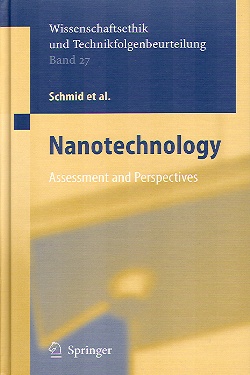Brune, H.; Ernst, H.; Grunwald, A.; Grünwald, W.; Hofmann, H.; Krug, H.; Janich, P.; Mayor, M.; Rathgeber, W.; Schmid, G.; Simon, U.; Vogel, V.; Wyrwa, D.
Nanotechnology.
Assessment and Perspectives
Berlin: Springer, ISBN 3-540-32819-X, 492 Seiten, 106,95 Euro
[Titelbild]
[Preface]
[List of Authors]
[Contents]
Foreword
 Technological challenges, resulting from political, social, economic or ecological
demands, can nowadays only be mastered by a strong integration of
different scientific disciplines. This is especially the case in Nanotechnology,
where the situation is arbitrarily complex due to the fact that Nanotechnology
ranges over all disciplines of natural sciences including medicine and
engineering. In nanoscience and -technology the classical differences
between physics, chemistry and biology lose their significance, synonymous
with a novel view of natural sciences. Nanotechnology is therefore much
more than an other kind of discipline, based on nanoscaled products in the
sense of a simple continuation of microtechnology. This description is by
far too simple. The incredible chances and possibilities offered by Nanotechnology
make it indeed the key technology of the new century, as is frequently
reported.
Technological challenges, resulting from political, social, economic or ecological
demands, can nowadays only be mastered by a strong integration of
different scientific disciplines. This is especially the case in Nanotechnology,
where the situation is arbitrarily complex due to the fact that Nanotechnology
ranges over all disciplines of natural sciences including medicine and
engineering. In nanoscience and -technology the classical differences
between physics, chemistry and biology lose their significance, synonymous
with a novel view of natural sciences. Nanotechnology is therefore much
more than an other kind of discipline, based on nanoscaled products in the
sense of a simple continuation of microtechnology. This description is by
far too simple. The incredible chances and possibilities offered by Nanotechnology
make it indeed the key technology of the new century, as is frequently
reported.
Faced with the accelerating developments in nanoscience and, in consequence, in nanotechnology, the Europäische Akademie Bad Neuenahr-Ahrweiler GmbH started an initiative with the aim to evaluate the state of the art in nanoscience and nanotechnology, considering not only the natural sciences, but - to the same extent - philosophical, ethical, toxicological and, last but not least, economic aspects. Besides the description of the state of the present situation, the book also considers possible future developments as far as they can be foreseen and gives recommendations to decision makers.
The working group, consisting of internationally acknowledged experts from all fields of nanoscience and -technology, began its activities on 1st July 2003 and organized from this time on monthly working sessions. The project was finished on 31st December 2005. On 8th October 2004, a Mid-Term Meeting was held in the Academy with prominent representatives of all fields of nanotechnology for getting response and valuable critics on the project at that stage. For this unrenouncable help the group would like to thank Dr. Gerd Bachmann (VDI-Technologiezentrum Düsseldorf), Professor Dr. Peter Bäuerle (Universität UIm), Professor Dr. Paul Borm (CEL Technohouse, Hogeschool Zuyd), Professor Dr. Harald Fuchs (Universität Münster), Professor Dr. Uwe Hartmann (Universität des Saarlands, Saarbrücken), Professor Dr. Christoph Hubig (Universität Stuttgart), Professor Dr. Martin Möhrle (Universität Bremen), Professor Dr. Reinhard Nesper (ETH Zürich), Professor Dr. Andreas Offenhäuser (Forschungszentrum Jülich), Dr. Markus Pridöhl (Degussa AG, Hanau), and Dr. Eberhard Seitz (Forschungszentrum Jülich).
Personally, I am anxious to thank the members of the working group for the enthusiastic cooperation over two and a half years, the valuable contributions during the numerous intense discussions, the patience, and the absolute will to bring this difficult task to a successful end. Special thanks go to Dipl.-Kfm. Nils Omland (WHU Koblenz) for his assessment of patent data used in this study.
The group's work was exemplarily supported by the co-workers and members of the Europäische Akademie, among numerous others especially Mrs. Margret Pauels, Dr.-Ing. Wolfgang Rathgeber and Dr. Gerd Hanekamp. Their overwhelming hospitality contributed substantially to the effective study progress. The excellent working atmosphere caused regular anticipation of the next meeting by each group member.
Günter Schmid
Essen, December 2005